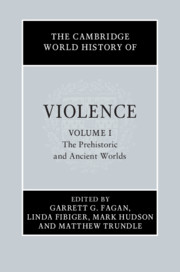Book contents
- The Cambridge World History of Violence
- The Cambridge History of Violence
- The Cambridge World History of Violence
- Copyright page
- Contents
- Figures
- Maps
- Contributors to Volume i
- General Introduction: Violence in World History
- Introduction to Volume I
- Part I The Origins of Conflict
- Part II Prehistoric and Ancient Warfare
- 8 Hunting and Warfare:The Ritualisation of Military Violence in Ancient Egypt
- 9 Recent Advances in the Archaeology of Maya Warfare
- 10 Violence and State Power in Early Mesopotamia
- 11 Violence and the Roman Way of Warfare
- 12 Roman Warfare and Military Violence in Late Antiquity
- 13 Violence and Warfare in Early Imperial China
- Part III Intimate and Collective Violence
- Part IV Religion, Ritual and Violence
- Part V Violence, Crime and the State
- Part VI Representations and Constructions of Violence
- Index
- References
10 - Violence and State Power in Early Mesopotamia
from Part II - Prehistoric and Ancient Warfare
Published online by Cambridge University Press: 13 March 2020
- The Cambridge World History of Violence
- The Cambridge History of Violence
- The Cambridge World History of Violence
- Copyright page
- Contents
- Figures
- Maps
- Contributors to Volume i
- General Introduction: Violence in World History
- Introduction to Volume I
- Part I The Origins of Conflict
- Part II Prehistoric and Ancient Warfare
- 8 Hunting and Warfare:The Ritualisation of Military Violence in Ancient Egypt
- 9 Recent Advances in the Archaeology of Maya Warfare
- 10 Violence and State Power in Early Mesopotamia
- 11 Violence and the Roman Way of Warfare
- 12 Roman Warfare and Military Violence in Late Antiquity
- 13 Violence and Warfare in Early Imperial China
- Part III Intimate and Collective Violence
- Part IV Religion, Ritual and Violence
- Part V Violence, Crime and the State
- Part VI Representations and Constructions of Violence
- Index
- References
Summary
Warfare and violence were central to the identity and experience of early states in the ancient Near East. This chapter focuses on the earliest historical records documenting the rise of kingdoms in early Mesopotamia and their relationship with violence and warfare. It argues that a rhetoric of state-sponsored violence developed in Mesopotamia that guided countless generations of behaviour. The only violence that was legitimate was state sponsored and divinely sanctioned. Kings promised to banish violence at home, except when performed under their auspices, and they pledged to bring the outside world to battle in a muscular extension of power over that world. The chapter is divided into three basic parts: first it introduces a series of related topics about how violence and warfare were imagined and understood in early Mesopotamia; second, it discusses violence in its early historical context by examining cycles of violence related to the growth of the state; and finally it will briefly examine the later development of these kingdoms of violence and the royal rhetoric that accompanied their creation and expansion.
- Type
- Chapter
- Information
- The Cambridge World History of Violence , pp. 219 - 237Publisher: Cambridge University PressPrint publication year: 2020
References
Bibliographic Essay
- 6
- Cited by

